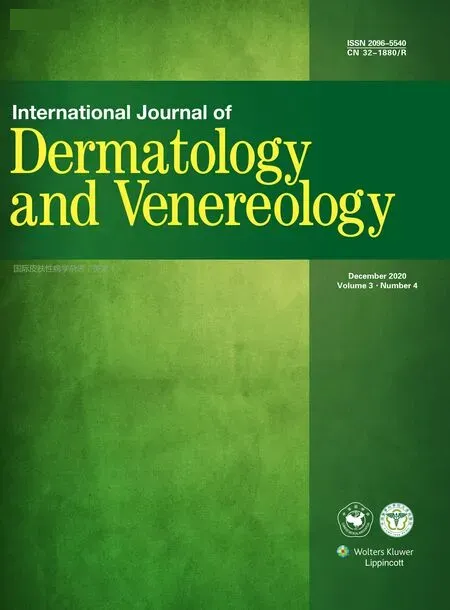Erosive Adenomatosis of the Nipple Masquerading as Paget’s Disease:A Case Report
2021-01-09QinGuoJinJiChengTanQiZhangSuYingFeng
Qin Guo, Jin Ji, Cheng Tan, Qi Zhang, Su-Ying Feng∗
1Department of Dermatology, the First Affiliated Hospital of Nanjing University of Traditional Chinese Medicine, Nanjing, Jiangsu 210029, China; 2Department of Dermatology, Hospital for Skin Diseases (Institute of Dermatology), Chinese Academy of Medical Sciences and Peking Union Medical College, Nanjing, Jiangsu 210042, China.
Abstract
Keywords: erosive adenomatosis of nipple, nipple adenoma, Paget’s disease
Introduction
Erosive adenomatosis of the nipple(EAN)is a relatively rare benign entity,clinically presenting as a palpable nodule,and involves an abnormal proliferation of the lactiferous ducts ofthenipple.This disease wasinitially describedbut lumped together with other breast papillary lesions as “benign intraductal papilloma” by Haagensen et al. in 19511and was first formally reported by Jones as a separate entity in 1955.2EAN is commonly seen in middle-aged women.Because of the presence of surface erosion and other alarming clinical observations,it is easily misdiagnosed as Paget’s disease. The diagnosis mainly relies on histolopathological evaluation of an excised specimen. Herein, we reported an EAN case masquerading as Paget’s disease,which should be paid more attention by clinicians.
Case report
The patient is a 21-year-old woman,presented to our clinic with a 6-year history of breast erythema with mild tenderness but no itching.On palpation,slight nodularity can be found in her left breast. She noted the lesion occasionally be covered by crust and exhibiting erosion with bloody discharge. The patient reported no personal history or family history of breast cancer. Upon examination, the skin overlying the nipple was rough and thickened with areas of erosion and superficial fissuring (Fig. 1A). Bilateral breast examination was otherwise unremarkable.Image studies including ultrasonography and mammography showed no abnormalities.An excisional biopsy was performed;on histopathological examination,focal epidermal erosion with a dermal florid epithelial proliferation with adenosis and papillomatosis is noted. There was no true fibrovascular core present. The hyperplastic epithelial proliferation was surrounded by intact bland myoepithelial cells with the stroma showing lymphoplasmacytic infiltrates; no features of malignancy were present (Fig. 1B and 1C).
Based on these findings, a final diagnosis of EAN was made. A simple nipple excision was performed, and there wasnoevidenceoflocalrecurrence over9months offollowup.The patient gave her agreement for case publication.
Discussion
Clinically,EAN is usually a unilateral lesion,although rare cases of bilateral nipple involvement have been reported.3EAN can mimic eczema in its early stages; however,Paget’s disease can enter the differential diagnosis in later stages due to erosion and erythema.
The histological differential diagnosis includes several cutaneous adnexal tumors ranging from benign lesions like syringomatous adenoma, hidradenoma papilliferum,syringocystoadenoma papilliferum,and intraductal papilloma to malignant lesions like ductal carcinoma in situ and invasive ductal carcinoma.4The histological features of EAN include a well-circumscribed and nonencapsulated ductal proliferation of glandular structures within the stroma of the nipple.There are always small components of adenosis, cystic dilatation, papillary hyperplasia,apocrine metaplasia, squamous metaplasia, and keratin cysts associated with EAN. Immunohistochemically, the outer myoepithelial cells can be highlighted by smooth muscle actin and P63, while the luminal lining cells are positive for CK7.
There are four histological types of EAN based on the WHO Classification of Tumors of the Breast4:(1)adenosis type;(2)epithelial hyperplasia or papillomatosis type;(3)sclerosing papillomatosis or pseudo-infiltrating type; and(4)mixed type.Our case had epithelial hyperplasia of the collecting duct epithelia and hyperplastic glandular ducts and could be classified as the second type, which is the most common type to be clinically mistaken for Paget’s disease of the nipple.
A new factor that could be used in the differential diagnosis between EAN and breast ductal carcinoma in situ involving the nipple has recently emerged.Takazawa et al.5noted a clear difference in the proportion of 5-hydroxymethylcytosine-positive tumor cells between EAN and ductal carcinoma in situ,implying that the presence of 5-hydroxymethylcytosine may be useful for the differential diagnosis of EAN from its malignant mimickers.Another helpful tool is dermoscopy, the usefulness of which has been described for a previous clinical workup.6
The treatment of EAN is complete surgical excision of the entire lesion with or without plastic reconstruction.7Mohs micrographic surgery is another treatment option.However, due to rare reports of EAN association or coexistence with breast cancer, any patient with a history of EAN is encouraged to maintain regular breast follow-up, and annual mammography screening should be advised if needed.

Figure 1. Clinical and pathological manifestations of the patient with erosive adenomatosis of the nipple. (A) A solitary 1.0cm×0.8cm erythematous eroded and crusted nodule on the left nipple. The epidermis is partially eroded,and the rest shows acanthosis.(B)The tumor is composed of proliferative ductal structures within the nipple stroma. The tubular ductal structures are lined by two-layered epithelium with the outer layer consisting of cuboidal cells and the luminal layer consisting of columnar cells,which in some areas show secretory projections at their luminal border (HE, ×100).
In conclusion, EAN is a benign ductal epithelial proliferation of the nipple, and unlike its mimics of Paget’s disease, it has no relationship with underlying breast cancer. Dermatologists and breast health care professionals need familiar themselves with this entity in handling cases involving nipple lesions to avoid unnecessary over treatment and causing patients harm.
杂志排行
国际皮肤性病学杂志的其它文章
- Instructions for Authors
- Platelet-Rich Plasma for Androgenetic Alopecia in Women: A Single-Center Case Series Study in Qatar
- Intracranial Abnormalities of Infantile Hemangiomas in the Head and Neck Regions:A Retrospective MRI Study
- Efficacy and Safety of Prednisolone Monotherapy Versus Prednisolone Plus Methotrexate in Erythema Nodosum Leprosum(Type 2 Lepra Reaction)
- The Past 70 Years in Control of Syphilis in China: Elimination and Responses to Resurgence
- Hair Matrix Cyst
